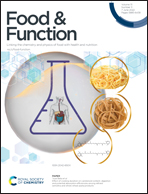Identification of novel antioxidant peptides from sea squirt (Halocynthia roretzi) and its neuroprotective effect in 6-OHDA-induced neurotoxicity†
Abstract
Ocean life contains a wealth of bioactive peptides that could be utilized in nutraceuticals and pharmaceuticals. This study aimed to obtain neuroprotective antioxidant peptides in sea squirt (Halocynthia roretzi) through protamex enzymolysis. Fraction F4 (ultrafiltration generated four fractions) had a lower molecular weight (<500 Dalton (Da)) with greater 1,1-diphenyl-2-picrylhydrazyl (DPPH) and 2,2-azino-bis (3-ethylbenzothiazoline-6-sulphonic acid) diammonium salt (ABTS) radical scavenging activities (94.24 ± 2.50% and 91.80 ± 1.19%). After gel filtration, six peptides, including Phe-Gly-Phe (FGF), Leu-Gly-Phe (LGF), Leu-Phe-VAL (LFV), Val-Phe-Leu (VFL), Trp-Leu-Pro (WLP), and Ile-Ser-Trp (ISW), were identified and sequenced by liquid chromatography-mass spectrometry (LC-MS/MS). Peptides WLP and ISW showed higher oxygen radical absorbance capacity (ORAC) values (2.72 ± 0.47 and 1.93 ± 0.01 μmol L−1 of Trolox equivalent (TE) per μmol L−1 of peptide) than glutathione (GSH). Additionally, WLP effectively increased cell viability, dramatically attenuated 6-Hydroxydopamine (6-OHDA)-induced cell apoptosis and decreased reactive oxygen species (ROS) levels to nearly two-fold, and significantly boosted glutathione peroxidase (GSH-Px) activity in PC12 cells. Transcriptome sequencing revealed differential expression of genes associated with various oxidative stress pathways after WLP treatment, such as glutathione metabolism. These results suggest that the Halocynthia roretzi-derived tripeptide WLP could alleviate neurodegenerative diseases associated with oxidative stress.

- This article is part of the themed collection: Food & Function HOT Articles 2022


 Please wait while we load your content...
Please wait while we load your content...